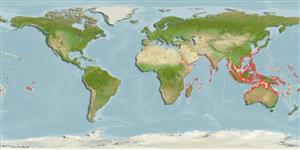Common names from other countries
Issue
The species in the genera Spratelloides Bleeker, 1851 and Jenkinsia Jordan & Evermann, 1896 should most probably be assigned to a separated family from Clupeidae and Dussumieriidae (Lavoué, pers. comm., July 2013). See a preliminary analysis in Lavoué et al. (2013: Ref. 93878).
Environment: milieu / climate zone / depth range / distribution range
экология
морской; пределы глубины ? - 40 m (Ref. 86942). Tropical; 33°N - 30°S, 33°E - 136°W (Ref. 188)
Indo-Pacific, from Red Sea south to Tanzania and east to Samoa (excluding the Cook, Society and Marquesas islands) and the Tuamoto Islands, north to southern Japan and south to western Australia and Kermadec Islands.
Length at first maturity / Size / Вес / Возраст
Maturity: Lm ?, range 4 - ? cm
Max length : 10.5 cm SL самец/пол неопределен; (Ref. 54980)
колючие лучи спинного плавника (общее число) : 0; членистые (мягкие) лучи спинного плавника (общее число) : 12 - 13; колючие лучи анального плавника: 0; членистые (мягкие) лучи анального плавника: 12 - 13. Maxilla toothed, triangular pre-maxillae, 2 supra-maxillae, second supra-maxilla asymmetrical (lower part larger than upper part), vertical striae on scales not meeting at center; W-shaped pelvic scute; few branchiostegal rays (6 or 7).
Usually an inshore schooling species, inhabiting relatively clear waters of coastal, lagoon, and seaward reefs (Ref. 11230). Relative fecundity is 1596 eggs per unit body weight (Ref. 4383). Caught with beach seines, purse seines, ringnets and dipnets. Marketed fresh or dried-salted (Ref. 5213). Used as bait in the tuna fishery.
Whitehead, P.J.P., 1985. FAO Species Catalogue. Vol. 7. Clupeoid fishes of the world (suborder Clupeoidei). An annotated and illustrated catalogue of the herrings, sardines, pilchards, sprats, shads, anchovies and wolf-herrings. FAO Fish. Synop. 125(7/1):1-303. Rome: FAO. (Ref. 188)
Статус Красного Списка МСОП (Ref. 130435)
CITES (Ref. 128078)
Not Evaluated
Угроза для людей
Harmless
Использование человеком
рыболовство: не имеет хозяйственного значения; наживка: usually
дополнительная информация
инструменты
Специальные отчеты
Скачать в формате XML
ресурсы в Интернет
Estimates based on models
Phylogenetic diversity index (Ref.
82804): PD
50 = 0.5625 [Uniqueness, from 0.5 = low to 2.0 = high].
Bayesian length-weight: a=0.00513 (0.00321 - 0.00820), b=3.11 (2.97 - 3.25), in cm Total Length, based on LWR estimates for this species & (Sub)family-body (Ref.
93245).
Trophic level (Ref.
69278): 3.1 ±0.0 se; based on diet studies.
устойчивость к внешним воздействиям (Ref.
120179): высокий, минимальное время удвоения популяции до 15 месяцев (K=0.41-0.44; tm<1; Fec=505).
Prior r = 1.19, 95% CL = 0.78 - 1.78, Based on 1 data-limited stock assessment.
Fishing Vulnerability (Ref.
59153): Low vulnerability (10 of 100).
Climate Vulnerability (Ref.
125649): High vulnerability (62 of 100).
